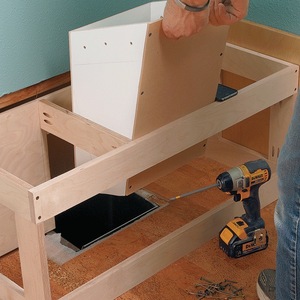hey all
I’m about to finish a room for my mother in law in the basement but before I do I want to beef up the ceiling . I’ve noticed a bit of bounce upstairs above that room
the floor joists are 2×10 and span roughly 11 feet . there is no real bracing. only one piece of straping running the lenght of the room
what is the best bracing? solid block bracing or cross? and on that kind of span (11 feet) would I only need to brace mid span or more?
and if I go with cross bracing.. what would be the best way to screw them in? mainly worried about how easy it would be to screw the top part of the cross brace (the one that sit wedged between the joist and the subfloor)
anyway, any tips are appreciated
thanks !
Pabs


















Replies
I'd draw a line across the bottom of the existing joists, midspan. Then, using solid 2x10 blocking, I'd fasten it with three fasteners at each end, alternating the blocking on the sides of the center line to ease the fastening chore.
You will be amazed how blocking will firm up the joists.
Bob.
Of course there are bound to be several bays where solid blocking won't work, due to wires or pipes.
You could try to find the extendable metal cross braces. They're designed to jamb in, so no fasteners needed.
For wood cross bracing you could either drive screws from the back side of the joist or cut the braces a bit short so they end a couple of inches shy of the floor sheathing, providing more clearance for fastening.
The guys at the ceramic tile form wil swear that cross bracing does little to stiffen a floor. What they recommend is creating your own modified version of an I beam. Glue and screw a 2x4 (6) to the bottom of each joist. In effect, it works just like an I joist. The joist becomes a much beefier web and the bottom 2x keeps the web (joist) from deflecting. The downside is you lose another 1.5 inches of headroom. But it quick and easy and works like a charm. My kitchen and living room both have the same span. I did the above under the kitchen prior to tiling and it doesn't move at all. I've had 40 + plus people in the Kitchen and you couldn't notice any bounce at all(yes its that large and they were lined up buffet style getting their food before they head 15 different directions to sit. You can feel the living room floor bounce any time you are laying on the floor or on one of the couches when kids walk over it (and they are mostly under 115 lbs). The living room will soon get the same treatment. And yes my original joists were cross braced in two different rows with site cut 1x lumber.
"http://johnbridge.com/vbulletin/show...droom+bathroom robbin View Public Profile Find More Posts by robbin 06-12-2008, 05:20 PM #14 Plainrider Registered User Join Date: Aug 2007 Location: Toronto, Ontario Posts: 302 To streamline the understanding of the suggested "bottom wood-flange" joist re-enforcement approach, I summarize some of the information on this method that I have discussed in the referenced thread. An easy & quick way to substantially increase the stiffness of 2x10 floor joists, for example, is to "screw & glue" 2 x 4s along the lower edges of the joists (see Figure 1 below). This approach eliminates the complications of adding sister 2 x 10s between existing floor joists and it more than doubles joist/floor stifness. A diagram of this approach is shown in Figure 2. Of course, a drawback of this method is that the actual "headroom" in the room below this re-enforced floor is reduced by 1.5 inches - although the 2x4s can act as strapping for the ceiling in the room below. Now, if 2 x 6s were added to the bottom of the floor joists (rather than 2 x 4s), floor stiffness would be increased even more, as is shown in Figure 3 (various combinations of floor joists and re-enforcing boards are shown in this Table). To use this Table, the Deflecto calculations can be increased by the indicated factors in the Table for various re-enforcing situations. Example: say you had calculated a Deflectio amount of L/400 for a certain 2x10 floor joist floor. But this is not quite stiff enough for an intended installation of natural tile. When you consult Table 3 for the 2x10 joist bottom-flange stiffening factors, you can see that the addition of a 2x4 bottom wood re-enforcement board would increae the joist stiffness by a factor of 2.1. Therefore, the equivalent deflecto reading for a 2x10 floor with added 2x4 re-enforcing joists would be L/840 - which is L/(2.1 x 400). Because the Deflecto stiffness criterion for a natural tile floor is L/720, you are able to quickly and easily beef up your floor for natural tile by adding bottom-flange 2x4s to the joists - an effort that typically takes about 20 minutes per joist! Michael Attached Images"
The guys at the ceramic tile
Duplicate
WOW a bounce in an 11 foot span?
Are they 24" O.C? I can not imagine a bounce on a 16 OC 2 x10 unless someone is an elepahant and a lead footed one at that.